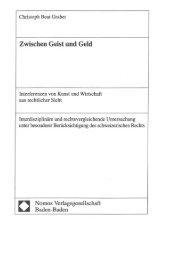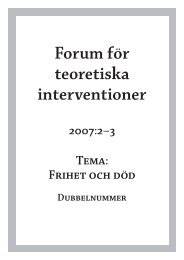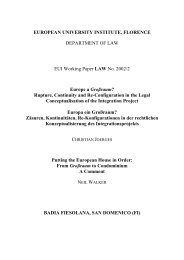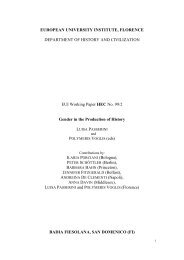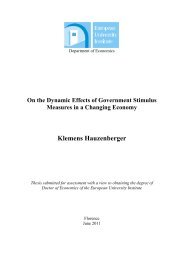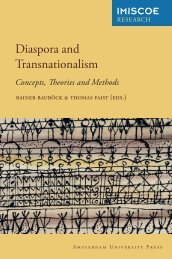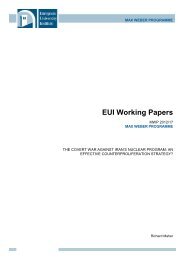Sinziana-Elena Poiana Ioana Lupea Irina-Madalina Doroftei Alina ...
Sinziana-Elena Poiana Ioana Lupea Irina-Madalina Doroftei Alina ...
Sinziana-Elena Poiana Ioana Lupea Irina-Madalina Doroftei Alina ...
You also want an ePaper? Increase the reach of your titles
YUMPU automatically turns print PDFs into web optimized ePapers that Google loves.
detriment of public interest) and the public role that it presumably fulfills. The rights of other religious<br />
minorities to study in an environment that enables their free development and choice of religious<br />
identification soon became marginal.<br />
Immediately after the fall of communism, Religion became a mandatory subject to be taught in<br />
primary and secondary schools. Religion was considered a promoter of the moral values that<br />
communism had destroyed. In most of the cases this was taught by Christian Orthodox priests, while<br />
the content was limited to Orthodox dogma and philosophy. In practice, some leeway did exist and<br />
communities that had a non-Orthodox majority were able to decide on the content of the class.<br />
However, even though the topic of teaching Orthodoxy in schools surfaced the public debate during<br />
the ‘90s, it was only in 2001 that Religion became an optional subject. Today, the class headmasters<br />
are required to inform parents and students on the optional character of Religion. However, a study<br />
conducted in 2006 showed that only 7.8% of Romanian students knew that they can opt out of the<br />
Religion class, 104 reflecting the general pro-Religion trend of the public discourse.<br />
The interwar discourse on Orthodoxy as a fundamental element of the Romanian self resurfaced in the<br />
public discourse in the mid ‘90s, mostly in connection to the fight against the communist atheism.<br />
Despite the presumed separation between state and church, excepting the select few, the main<br />
discourse has been in favor of the state’s actions to support the Romanian Orthodox Church, in the<br />
virtue of the absolute Orthodox majority of the Romanian population and the public function that the<br />
Church is thought to fulfill. Even though the debate on teaching religion in schools had been ongoing<br />
since it became a mandatory subject in January 1990, talking about displays of Christian<br />
representations in school seemed a rather progressive debate topic. However, in 2006 Mr. Emil Moise,<br />
a philosophy professor, filed a complaint with the National Council for Combating Discrimination<br />
(CNCD) claiming that paintings of Christian figures that hanged on the school’s walls were a breach<br />
of the non-orthodox students’ right to free choice of confession and impeded the free development of<br />
the spirit of the rest of the students. After the case reached the public agenda, Mr. Moise was literally<br />
harassed by media, politicians and the Orthodox Church. His civil lawsuit against the Romanian<br />
Government had reached the High Court of Cassation and Justice two years ago. But it became clear<br />
that there is a newly established tradition pushed to the public agenda by representatives of the<br />
Orthodox church to great success, and that the state policy supports the promotion of Orthodox values<br />
in schools to the detriment of other confessions.<br />
Tolerance and Diversity Challenges in Political Life<br />
The victory in November 1996 elections of the centrist coalition in Romania – the only alternative to<br />
the post-communist and nationalist alliance which had ruled since 1990 – brought an area premiere<br />
that remained if not unnoticed then little analyzed. As a consequence of the victory the ally - since<br />
1991 - of the winner Democratic Convention of Romania (CDR), the Hungarian alliance (DAHR)<br />
joined the new-formed government. The event has a twofold importance: in broader European terms,<br />
since DAHR was at the time the largest ethnic party in Europe, representing the 1.7 million<br />
Hungarians and enjoying almost 7 % of the total seats in the Romanian Parliament, and in the Balkan<br />
area, where such collaboration was rarer and rarer.<br />
One would have expected such a move to appease nationalists in both camps. However, the presence<br />
of DAHR in the government proved to be a daily struggle, of the government with the media and a<br />
rebellious Parliament, of the DAHR leaders with various discontent wings of their party, of the<br />
Romanian coalition leaders with their MP and followers. Although the major improvements in the<br />
Hungarians’ self-government promoted by the government (such as appointment of Hungarian<br />
prefects in Hungarian dominated-areas of Transylvania) brought no popular discontent, the debate on<br />
what the status of the Hungarian community in Romania should be, was only reopened. The major<br />
104 http://www.proeuropa.ro/norme_si_practici.html<br />
78



